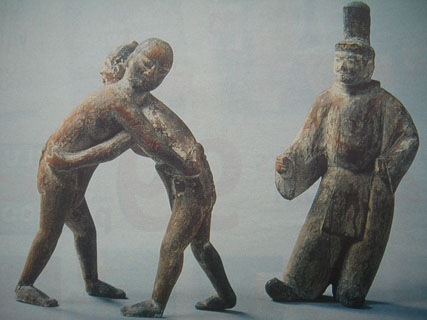This week’s column is dedicated to Victor Harris, a remarkable gentleman who works in the British Museum’s Department of Japanese Antiquities. During his time there he has organised many fascinating exhibitions, on subjects ranging from the swords of the samurai to the sculptures of the Kamakura period. His latest, a display devoted to “Shinto: The Sacred Art of Ancient Japan”, is perhaps the most extraordinary yet. It contains an unprecedentedly large number of those extremely special objects categorised by the Japanese government as “Important Cultural Property”. Drawn largely from shrines and other holy sites in Japan, many have never been placed on public display before. The exhibition closes in just one week. Today’s picture shows one of my favourite things in it: a group of small but profoundly expressive wood-carvings depicting Two Figures Wrestling, with a Referee, which have been borrowed from the Mikami Shrine near the sacred mountain Mount Mikami in the Shiga Prefecture of Japan.
Shinto, which comprises both the most ancient and the most persistent network of Japanese religious beliefs, defies capsule definition. Over the centuries it has absorbed many influences from Buddhism, Daoism and other religions, but its origins are believed to lie in prehistoric shamanistic practices: forms of nature worship, or expressions of gratitude to nature, which sustained faith in a vast number of deities of the land, sky and sea. Shinto allows for a remarkable diversity of gods. An entire mountain can be regarded as a kami but so, equally, can a single rock or even stone. The Nihongi [itals] , an early eighth-century text, refers to “the eight million gods”.
Shinto’s myths and stories are peopled, predictably, by a somewhat confusing multitude of divinities. The significance of the wrestling figures shown on this page is to be found in the tale of...

ITP 84: Two Figures Wrestling, with Referee, Anonymous Japanese craftsman
25-11-2001

